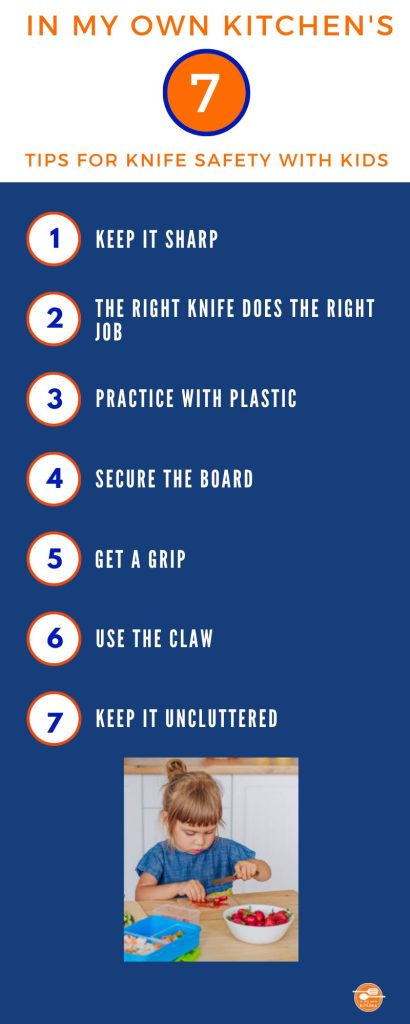Cooking with kids – knife safety

Seven Tips for Knife Safety with Kids
Cooking with kids is such a fun and memorable experience. Safety is one of the top priorities in any kitchen and using a knife safely is essential. Kids can learn kitchen confidence and become a willing helper in the kitchen with these safe tips to get them chopping, slicing and dicing with ease. Feel free to print my info graphic for easy reference when cooking with kids!
Tip One – Keep it sharp
I can’t stress enough how much safer a sharp knife is. I know it can seem counterintuitive but a sharp knife does the job properly – accidents can happen when blunt knives need too much pressure to slice or chop through your ingredients. Small hands already grapple with a knife, adding pressure to their chop can create an unstable technique.
Tip Two – The right knife does the right job
Knives come in all shapes and sizes and each knife has a specific job and adds to the ease in which a task is completed. A small knife is easy for small hands to handle in the initial stages of learning how to cut. That being said ensure the small knife is used for small tasks – topping and tailing beans, cutting up soft meats like chicken, slicing herbs and cutting smaller sized potatoes. When your kid/s becomes more confident and able to complete harder cutting techniques a cooks knife is recommended for chopping, slicing and dicing. These larger knives are made to complete specific tasks – the front for precision slicing and the heel or back for rocking chopping and cutting hard vegetables.
Tip Three – Practice with plastic
To get your kid/s used to chopping use a plastic or lettuce knife and practice with soft foods such as bananas, grapes and hard boiled eggs. Even play-dough or salt dough can work a treat to create knife confidence.
Tip Four – Secure the board
On some surfaces a chopping board can slip and slide creating an unstable surface and accidents to follow. To secure your board just dampen a dishcloth or paper towel placing it underneath the chopping board then checking for any wobble.
Tip Five – Get a grip
Securely gripping the knife can make a difference in technique confidence – try and mirror the following pictures to get a grip and become confident
Tip Six – Use the claw
Wayward fingers are like targets for a slipping knife. Tucking fingers away prevents dangerous slips cutting into fleshy fingers. The claw can feel uncomfortable at first but it is the best way to control the item you are cutting and keep fingers cut free. To get little hands used to the claw, teach them to cut smaller items they can grip easily. I halve large onions for them to practice on, cut down large carrots into more manageable pieces and halve potatoes. They still get to practice but in a more manageable manner.
Tip Seven – Keep it cool
Watching anyone learn to cut with a sharp knife be they kid or adult can be stressful. Accidents do happen and cuts are distressing but hovering anxiously adds to the pressure to get it right. I always keep a watchful eye on the chopping but with enough distance they feel they are in charge of their skill. Speaking calmly and reminding them to hold their knife properly and use the claw will keep them on track and cuts out of the picture. In the learning stages the technique is more important than the outcome. So some of the onion is a little chunky or the dices a little wonky. These outcomes are arbitrary when cooking at home. Even as an apprentice my cutting technique needed constant revision and honing. I was taught to cut on items that were either going into a soup or stock or being blended so the final outcome was reliant on my technique. As my confidence grew and technique refined I was able to complete more precision cuts. For now, just keep it cool and allow your kid/s to hone their technique one chop at a time.
